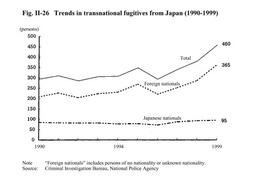| Previous Next Index Image Index Year Selection | |
|
|
1 Transnational fugitives from Japan Fig. II-26 shows trends in the number of suspects who have fled the country following offenses committed in Japan over the last ten years. The number of transnational fugitives from Japan has been increasing since 1997, reaching 460 (20.7% more than in the previous year)in 1999. In terms of their nationality, Chinese nationals were the most numerous with 163 (35.4% of the total), followed by Japanese with 95 (20.7%), North and South Koreans with 33 (7.2%), Brazilians with 22 (4.8%), Thais with 20 (4.3%), Iranians with 16 (3.5%), and Hong Kong citizens with 14 (3.0%).
By type of offense, 362 (including 72 Japanese nationals)were wanted in connection with penal code offenses. Of these, the most common were heinous offenses(here taken to mean homicide, robbery, arson, and rape), accounting for 144 suspects(including 21 Japanese), followed by larceny with 121 (9), intellectual crime(fraud, embezzlement, forgery, giving or taking bribes, and breach of trust)with 67 (36), and violent crimes(assault, bodily injury, intimidation, extortion, and unlawful assembly with dangerous weapons)with 8 (3). Meanwhile, 98 fugitives(including 23 Japanese nationals)were wanted for special law offenses, of which the most common were drug-related offenses(Stimulant Drug Control Law violations, Narcotics Control Law violations, Opium Law violations, and Cannabis Control Law violations)with 36 (12), followed by Immigration Control Law violations with 30 (3) and Firearms and Swords Control Law violations with 3 (0). In terms of the presumed destination country(or region)of transnational fugitives from Japan in 1999, the most common was China with 81 (including 4 Japanese nationals), followed by the Philippines with 30 (21), North and South Korea with 21 (3), the United States of America with 14 (13), Taiwan with 11 (3), and Hong Kong with 10 (2). Of the 460 transnational fugitives from Japan in 1999, the date of departure from Japan was known for 142 (including 41 Japanese nationals). Viewing this departure date in relation to the date of the alleged offense, 3 of these 142 fugitives(including 1 Japanese national)escaped on the day of the offense,15(3)on the day after the offense, 7 (2) two days later, 7 (1) three days later, and 6 (0) four days later. In all, 47 suspects (33.1%) fled the country within ten days of the alleged offense and 63 (44.4%) within thirty days(source:Criminal Investigation Bureau, National Police Agency). Fig. II-26 Trends in transnational fugitives from Japan (1990-1999) |
